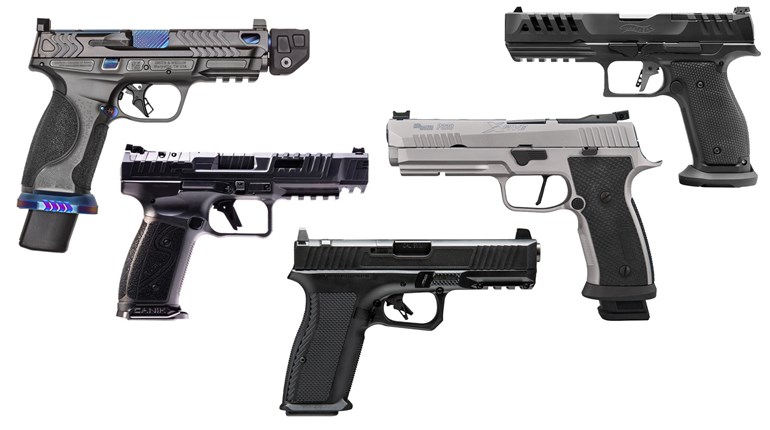
WARNING: All technical data in this publication, especially for handloading, reflect the limited experience of individuals using specific tools, products, equipment and components under specific conditions and circumstances not necessarily reported in the article and over which the National Rifle Association (NRA) has no control. The data has not otherwise been tested or verified by the NRA. The NRA, its agents, officers and employees accept no responsibility for the results obtained by persons using such data and disclaim all liability for any consequential injuries or damages.
Once in a while, something new comes along that gets your attention. This certainly applies to the two-piece 9mm Luger cases recently introduced by Shell Shock Technologies. This innovative design has a nickel alloy stainless cylinder body attached to a nickel-plated aircraft-grade aluminum base.
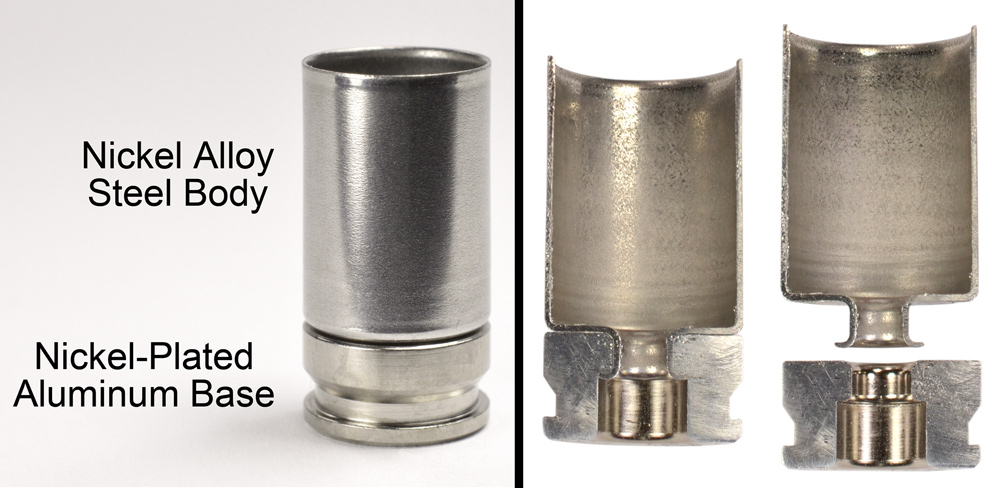
The aluminum base is roughly .20-inches tall, and the remaining body is comprised of the nickel alloy cylinder. The two-piece cases are attached via the flash hole, which is an integral part of the nickel alloy body extending down into the aluminum base. Accordingly, these cases have larger flash holes than usual brass cases. This helps to eliminate back pressure.
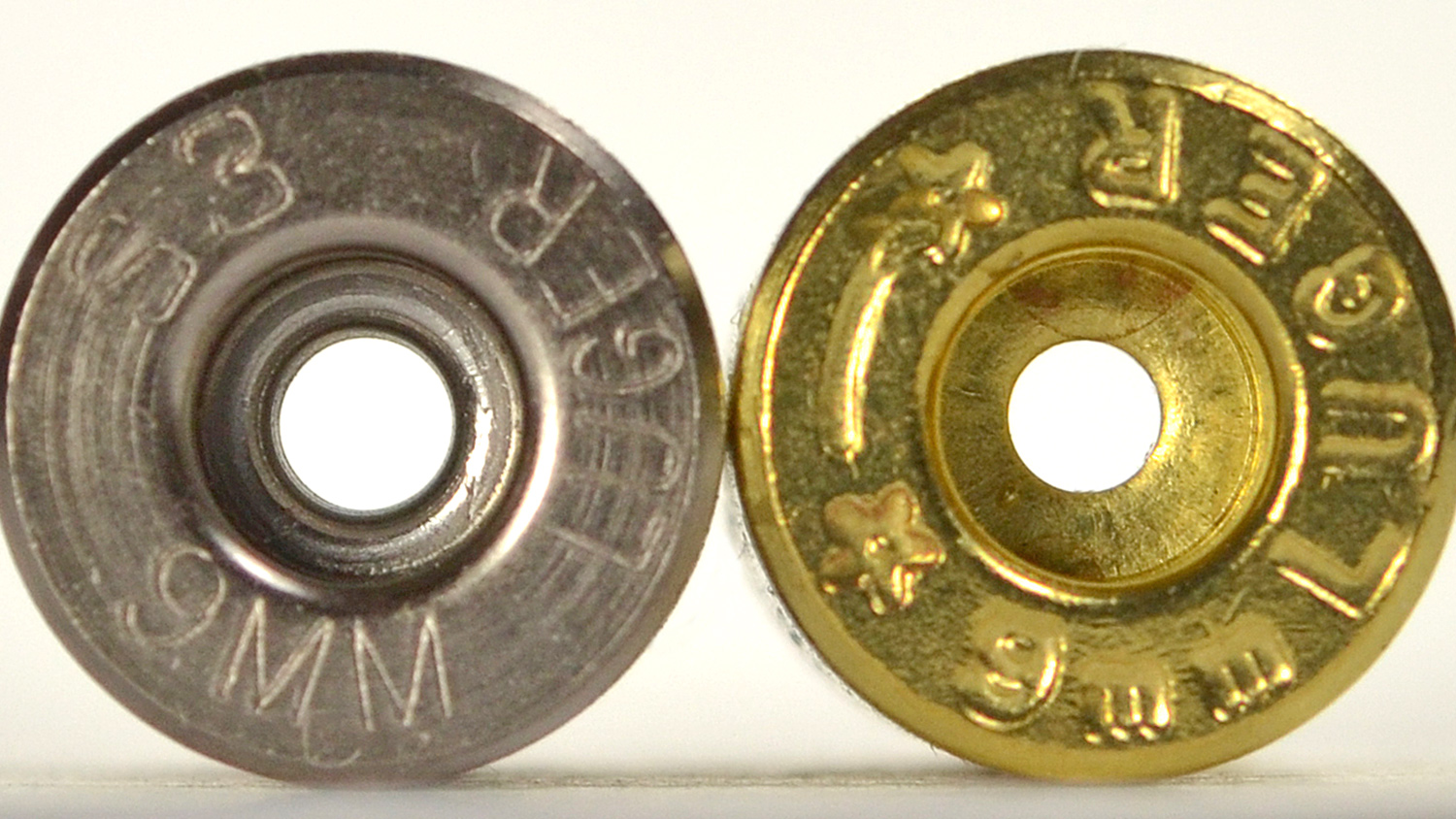
The Nickel Alloy Shell (NAS3) cases have purported advantages over conventional brass cases. They are 50 percent lighter, less abrasive, stronger—which makes them ideal for +P and +P+ loads, and won’t “balloon” when fired in unsupported chambers. Self-lubricating and corrosion resistant, they won’t split, chip or crack, and they’re ferrous so you can pick them up with a magnet (finally!).
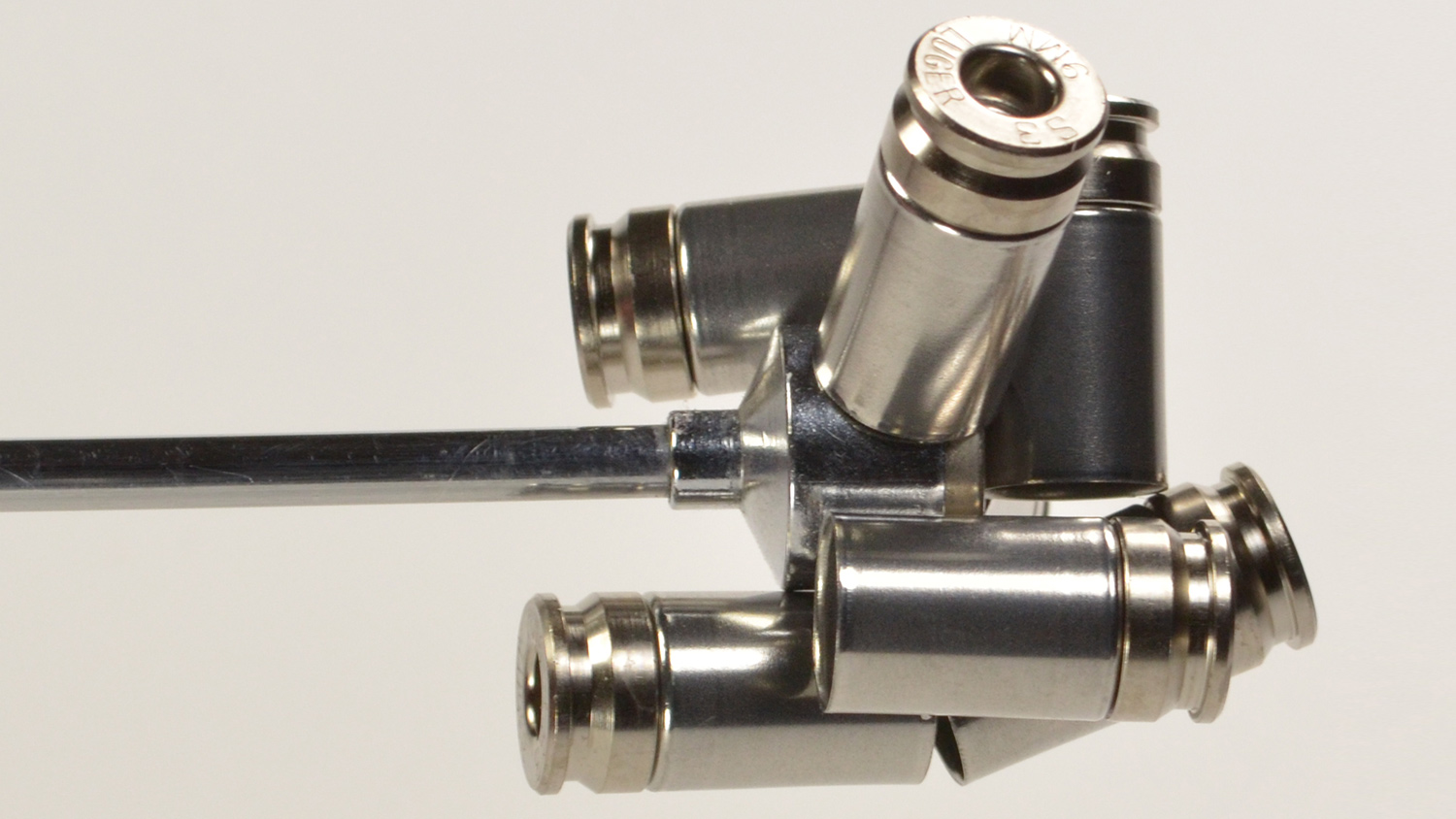
NAS3 cases are reloadable with special dies made by S3 Reload. They claim these cases can be loaded up to five times more than regular brass cases, and have a link on their website showing the same case being loaded 32 times to back that up.
Reloading NAS3 cases is no different than loading brass cases, with the exception of requiring both a special sizing and flaring die. The dies have standard 7/8-14-inch threading to fit nearly all loading presses. The sizing die has a carbide insert, but the cases require lubrication during the sizing step, just like you would for bottleneck cases. I used Hornady ONE SHOT and it worked fine. The sizing die can be used with regular brass cases, as well.
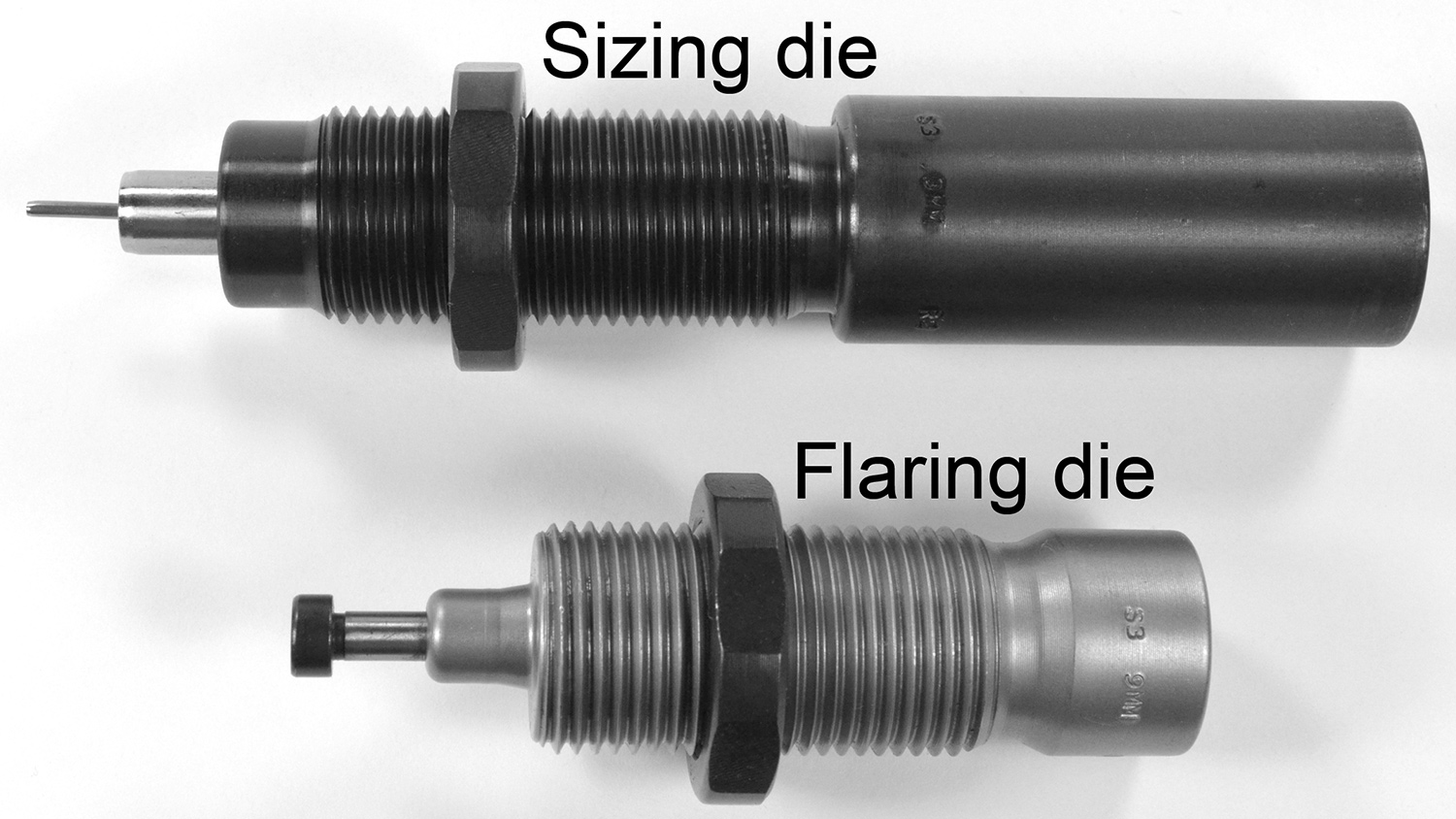
The sizing die has a polyurethane spring that pushes the sized case out of the die so that it is not pulled out of the die strictly by the shell plate, which could pull it apart or stretch it. The flaring die is spring-loaded for the same reason.
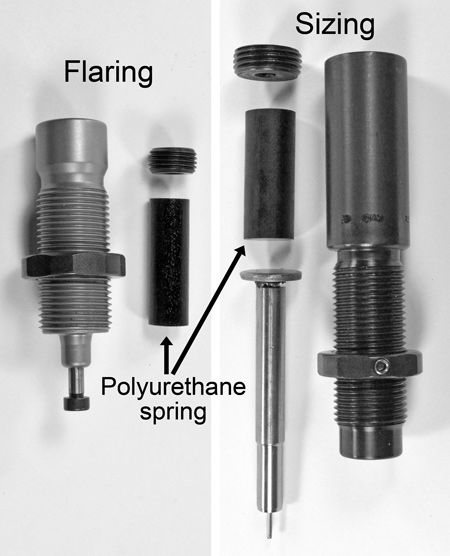
The cases can handle some pull-stress without stretching or separating but there are limits. I pulled a few bullets from loaded cases and in some instances there was evidence that the steel alloy body was stretched slightly away from the base. The overall length of the case had increased by 10 to 15 thousandths of an inch, and the gap between the two halves was visibly wider. Some cases did not stretch at all when the bullet was pulled. Any cases that have stretched past the SAAMI length of .754-inch should be discarded.
Sizing the NAS3 cases makes a clunking noise when the case is pushed from the sizing die back against the shellplate/shellholder. Normally the shellholder pulls the case from the die, but with these cases and the spring loaded size die, the case gets pushed out with a bit of force. It might sound weird, like something is broken when you first hear it, but it’s perfectly normal. Here is a video that explains the noise.
Upon seeing the NAS3 cases, I first noticed that the inside bottom of the case was higher than regular brass cases. I measured the distance from the case mouth to the bottom of the powder chamber in new NAS3 cases and new Starline 9mm brass cases. The internal depth of the NAS3 case was nine percent shorter than that of Starline cases.
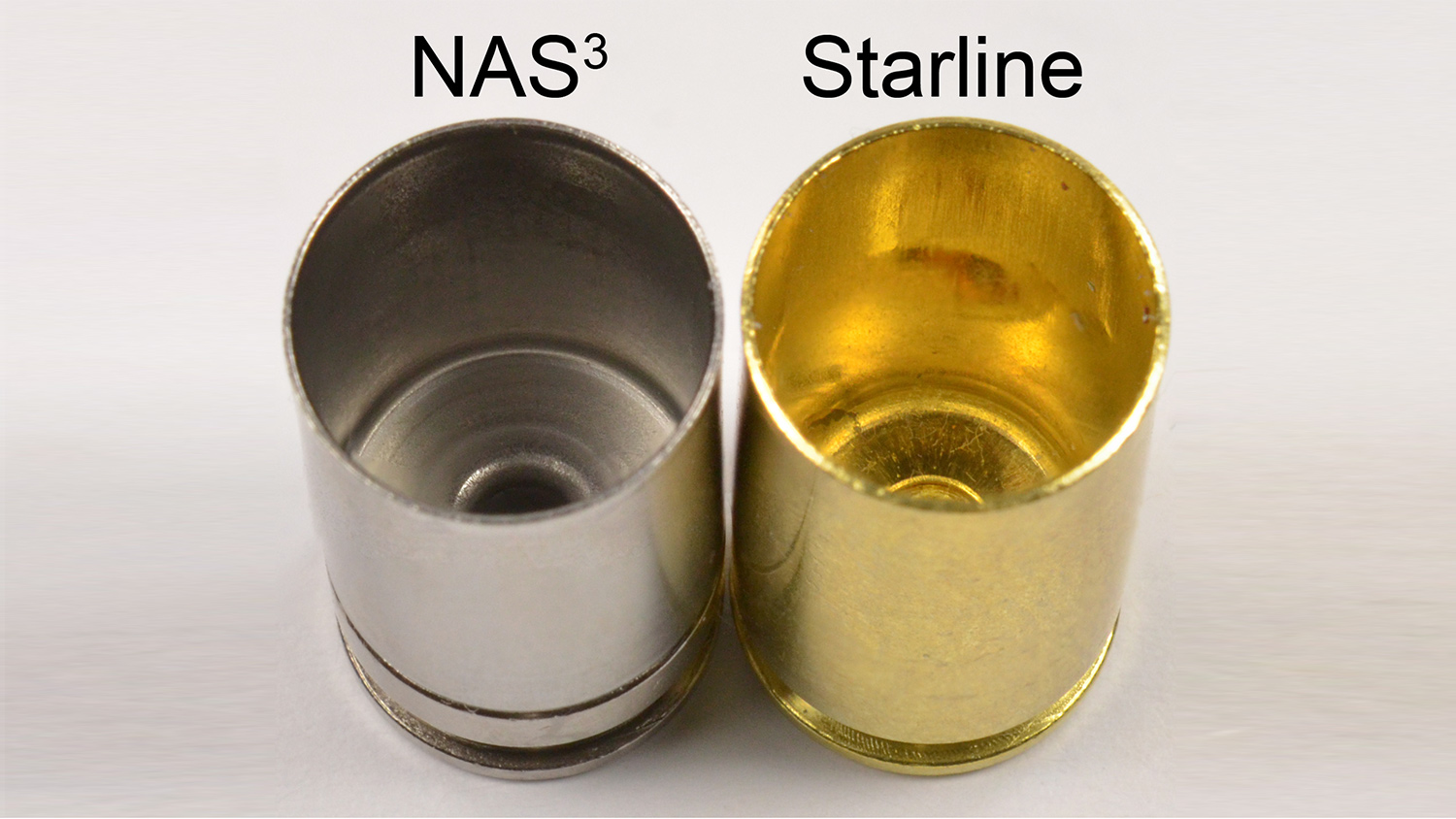
This could mean that the NAS3 cases have less capacity than regular brass cases. They don’t. Shell Shock says that NAS3 cases have fractionally more capacity than a standard 9mm case. This was confirmed by measuring how much Accurate #7, a fine-grained powder, they would hold. The Starline brass held 13.9 grains, while the NAS3 case held 14 grains.

The case walls of both brands were the same .012-inch thickness when measured at the case mouth. As you go deeper in the case, the walls thicken, but the NAS3 wall thickens less. When I put my calipers in the case as deep as I could (which appear to be at essentially the same depth in both brands), the NAS3 wall thickness was .023-inch while the Starline wall measured .038-inch.
Four handloads were tested in NAS3 cases with bullets up to 165 grains and compared with Starline brass cases. The velocity was higher in all four loads with the NAS3 cases. Average increases in speed ranged from 18 to 44 fps depending on the load, though it’s not clear why. The greater case capacity of NAS3 cases should actually produce similar or slightly lower speeds, not higher. Despite this, for whatever the reason, the NAS3 cases produced faster speeds than the brass cases when loaded with the same charge.
The loads were tested for accuracy at 25 yards with the gun, a Para Ordnance pistol with a 5-inch Kart barrel, in a Ransom Rest. A single 15-shot group was fired. There was no overall difference in accuracy when comparing the NAS3 and Starline cases. Two of the loads produced a smaller group with NAS3 cases and two were larger. That said, switching to NAS3 cases might require you to rework your loads to find the best accuracy because of the increase in velocity, or a reduction in your load for the same velocity.
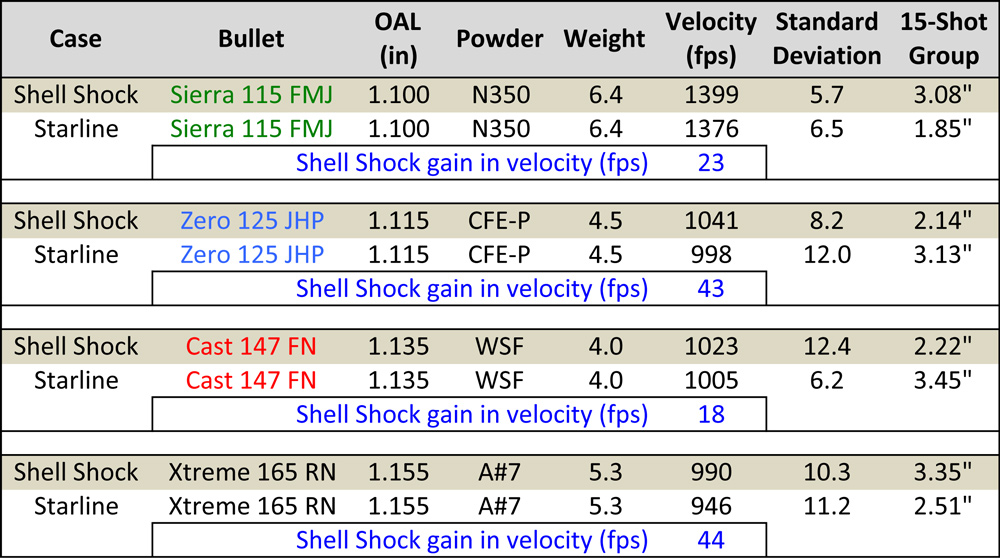
Shell Shock’s advertising says that their uniform wall thickness and proprietary assembly techniques produce reliable and consistent velocity. An independent test report by H. P. White Laboratory, Inc. recorded a standard deviation of only .93 fps. Using Titegroup powder in a 10-shot string, their extreme spread was a mere 4 fps. However, that was a sample of one, and an exceptional example at that. My extreme spreads and standard deviations in NAS3 cases were much larger (see the Table) and did not show a uniform improvement compared to brass cases.
Crimp and Glocks
Crimp is always important, and might be especially important with NAS3 cases for some Glock pistols, as I experienced extraction failures with improperly crimped NAS3 cased ammunition in my Glock 19C. During the extraction phase in my Glock, the barrel unlocks and drops down low enough that the rim of the extracting case is exposed to the case mouth of the top round in the magazine. The case mouth has a very sharp edge and can snag the edge of the extracting round’s rim, preventing the fired case from extracting. Shell Shock Technologies advised me that they have not seen this in their tests of Glock pistols. This type of malfunction has also been reported in a Glock 43 by another shooter however, one Dr. Martin D. Topper. Whatever the case, I stopped extraction failures in my Glock by applying a -.003-inch crimp. Glock owners who experience the same problem I did should give this a shot to remedy the issue.
Summary
Loading NAS3 cases is just like loading regular brass cases. I experienced no problems setting up the dies and cranking out several hundred rounds of ammo. Other than requiring lubrication, which I don’t normally use for non-bottleneck pistol cartridges (though some people do), and the clunking sound made during sizing, it’s reloading as usual.
Part of the appeal of these cases is that they’re magnetic. If you’re a re-loader, you have to pick up your cases, and a magnet can make that task easier. I was able to pick up three or four cases at a time at the range with my moderate strength magnet, though as the NAS3 cases are not strongly magnetic. A strong magnet is the best tool for picking them up. Be warned, however! Any steel rifle cases on the ground, will be more strongly attracted to the magnet than the NAS3 cases.
All that said, NAS3 cases are an interesting product with several advantages over brass. There is no reason to doubt that they can be loaded as many times as claimed for standard pressure loads, and thus could offer a practical way to stretch your reloading dollar.
Do the advantages of NAS3 cases make them worth switching to? Each person has to decide that for themselves. With respect to cost, the dies cost $80-$100, but the NAS3 cases are less expensive than brass ones: 1000 new NAS3 cases cost $100, whereas 1000 new brass cases cost a good bit more. Some of the lowest prices I know of for new, high quality brass cases are from Starline, and they run $130 per 1000. If you want new Winchester, Remington or something else of that quality, expect to pay much more, like $200-plus per 1000. The money you save on cases will quickly pay for the reloading dies.















